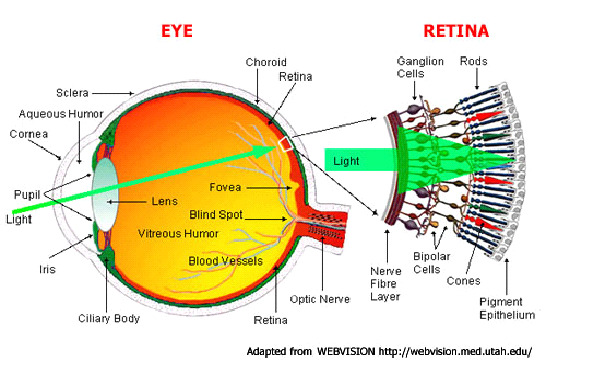
Photography is the manipulation of light to create and fix images. The study of light and the way it behaves is Optics. The physical properties of light, such as wavelength and refraction, determine the way it can be used, but ultimately, images are only recognized and interpreted by the complex mechanism of the eye and brain. Photography is the perception of the physical process.

Techniques: Optics and How They Work
Sight begins when light rays from an object enter the eye through the cornea, the clear front “window” of the eyeball. The cornea is actually responsible for about sixty percent of the eyeball’s light-ray-bending capability. The cornea’s refractive power bends the light rays in such a way that they pass freely through the pupil, the size-changing hole in the iris.
The Iris, the structure that gives the eye color, works like a shutter in a camera. It has the ability to enlarge and shrink, depending on how much light the environment is sending into the eye.
After passing through the iris, the light rays strike the eye’s Lens. This clear, flexible structure works much like the lens in a camera – shortening and lengthening its width in order to focus light rays properly.
In a normal eye, after exiting the back of the lens, the light rays pass through the Vitreous -- a clear, jelly-like substance that fills the globe of the eyeball. The vitreous humor helps the eye hold its spherical shape.
Finally, the light rays land and come to a sharp focusing point on the Retina. Continuing with our “camera” analogy, the retina’s function is much like the film in a camera. It is responsible for capturing all of the light rays, processing them into light impulses through millions of tiny nerve endings, then sending these light impulses through over a million nerve fibers to the Optic Nerve.
The optic nerve is sort of like an extension of the brain. It is a bundled cord of more than a million nerve fibers. The light impulses travel through this nerve fiber to the brain, where they are interpreted as images.
Cornea - Iris - Lens - Retina - Optic Nerve - Brain = Vision

Rods and Cones of the Retina Wall
Cones - light sensitive , pigmented chemicals in the cones react to different wavelengths of red, green or blue to record color.

Rods - insensitive to color, but very sensitive to the intensity of light and contain a pigment called rhodopsin.


Rods and cones are NOT evenly distributed across the retina. In the Fovea, there are only cones. While the entire retina contains a mixture of rods and cones, the exact center of the retina contains the fovea, which is entirely composed of high-resolution cones, providing approximately a three-degree high-resolution window.


No comments:
Post a Comment